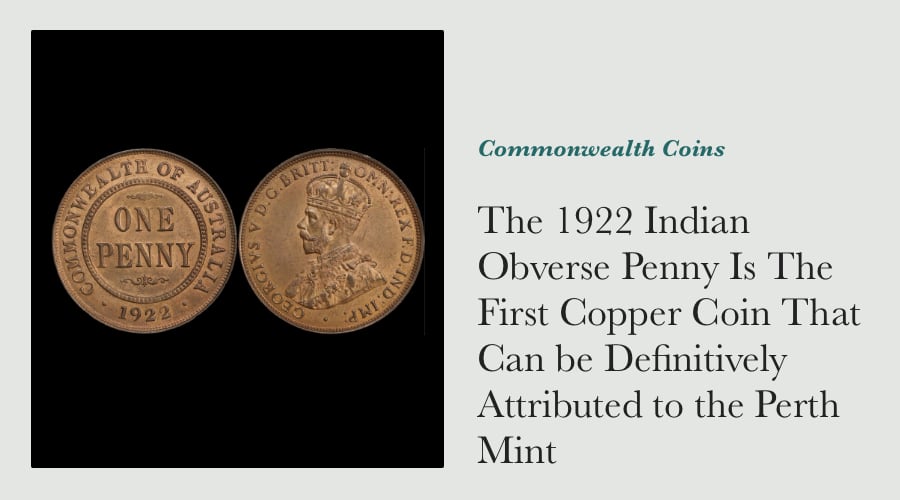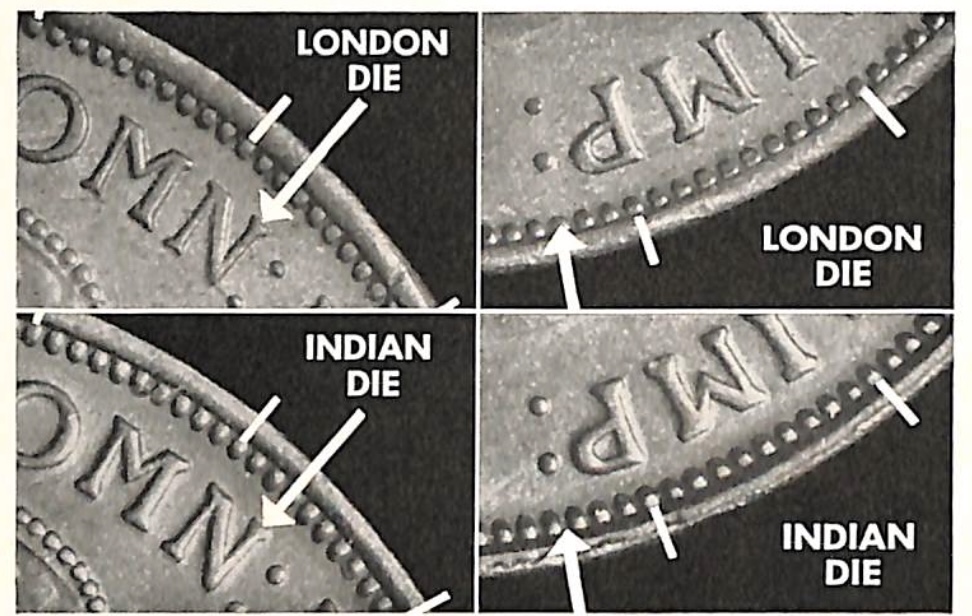The 1922 Indian Obverse Penny Is The First Copper Coin That Can be Definitively Attributed to the Perth Mint

Australia’s monetary system was under a great deal of strain in the early 1920’s – the population was growing strongly, and the national economy was recovering following the end of World War I.
As a result, vast numbers of pennies and halfpennies were minted each year to keep pace with the general public’s requirement for loose change.
The increased and continual demand for small denomination coins placed a great deal of strain on the operations of the Sydney and Melbourne mints.
Several senior figures in the Commonwealth Government and the Royal Mint solicited ideas on how the needs of the economy for sufficient coinage could be met efficiently and effectively.
The history of Australian numismatics shows that several alternatives were explored, including:
- The introduction of smaller and more durable copper-nickel coins;
- Reducing the purity of silver in the higher denomination coins; as well as
- The introduction of a five-shilling note.
The patterns and specimens related to these proposed changes are of immense interest to historians and collectors today.
The Perth Mint Is Called Into Action To Cover The Western Half
The shortage of copper coins in the monetary system was particularly acute in 1921, and as both the Sydney & Melbourne mints were working to full capacity at the time, the Commonwealth Government requested that the Perth mint share the burden by producing enough pennies to supply the Western half of the nation.
Although the Perth Mint obviously had the machinery and staff required to perform this extra work, it was necessary to modify two coining presses before they could produce large volumes of pennies – the penny is a much larger coin than the sovereign, and copper is, of course, less malleable than gold.
The first penny dies arrived at the Perth Mint on November 18th, 1921.
An examination of mint records indicates that reverse dies dated 1920, 1921, and 1922 were among those sent to Perth during this period.
The first production run of pennies was finished by mid-December 1921, with subsequent batches being produced intermittently until February 1923.
All of the pennies produced by the Perth Mint during this period were distributed exclusively via the network of banks within Western Australia.
It seems that the increased output of copper coins by the Sydney, Melbourne, and Perth mints between 1919 and 1922 eventually satisfied the economy’s demand for circulating coinage.
In 1923, the Commonwealth Treasury reverted to its policy of forwarding all orders for copper and silver coinage to the Sydney and Melbourne mints. Perth was no longer considered for this work for several reasons:
- Due to declining gold receipts, the Sydney and Melbourne mints were operating below capacity, and therefore they had adequate capacity to handle the additional work of producing Commonwealth coinage;
- As Perth was far from the major population centres of the Eastern seaboard, it was more efficient to produce coins in Sydney or Melbourne whenever possible.
The production of King George V copper coins at the Perth Mint in the 1920s is therefore confined to the dates 1920, 1921, and 1922.
Problems In Attributing Pennies Dated 1920 and 1921 To The Perth Mint
From a collector’s point of view, there is an element of pride in owning one of the first coins produced by a mint, particularly when it remains in impeccable condition.
As the Perth Mint produced pennies dated 1920, 1921, and 1922, it is obvious that collectors would be most interested in obtaining one of the pennies dated 1920 - logic dictates they would have been the first pennies produced.
Unfortunately, it is not possible to definitively attribute a 1920-dated penny to the Perth Mint. The die combinations employed by the Perth Mint were also used at either Melbourne or Sydney (or both). Discerning penny collectors will be aware that there are 8 different die varieties of the Australian 1920 penny - some of these can be definitively attributed to either the Sydney or Melbourne Mints, the coins struck from the remaining die pairs were struck across more than one mint.
Research published (separately) by Fred Lever and Mark Duff touches on numerous factors that point to the Perth Mint being the most likely location for the production of the 1920 Penny with the English obverse and a dot above the lower scroll on the reverse. The records held in the various die registers of each of the branch mints do not support that being concluded definitively, but as most of the known examples of this date have been discovered in Western Australia, that is not an unreasonable conclusion to draw.
Although there are two different varieties of the 1921 penny (most with the Indian obverse, a smaller proportion with the London obverse), several mints used the same die combinations to strike pennies during this year also, so they cannot be attributed to a specific mint.
It is only when we come to the pennies dated 1922 that some can be unequivocally attributed to the Perth Mint.
The Indian And English Obverse Penny Dies

KGV Penny Obverse Identification
There are two different types of King George V obverse die - they are known as the English and Indian obverses. Research of mint records indicates that the English obverse die of King George V came into use at the Melbourne Mint towards the end of 1921, meaning that all pennies made by the Melbourne Mint dated 1922 feature the English obverse.
Research that has been based on the currently available records indicates that the obverse dies sent to Perth however were the Indian type. Therefore, pennies made by the Perth Mint in 1922 feature the Indian obverse of King George V.
The Sydney Mint did not strike pence dated 1922, while the Melbourne Mint used only English obverse dies during 1922.
This subtle yet distinct difference allows collectors to simply and definitively identify the pennies produced by the Perth Mint in 1922 - the chart used by numismatists to do this is shown here.
As the first copper coin that can be unequivocally identified as being produced by the Perth Mint, the 1922 Indian obverse penny is of immense interest to Australian coin collectors.
Further Reading
John Sharples, Australian Coinage 1919 ~ 1924, Journal of the Australian Numismatic Society, Volume 1(July 1985), Self Published, Sydney, pages 4 to 18.
Anthea Harris, Australian Circulating Currency - the Perth Mint’s Contribution, The Australian Numismatic Post, August 1998, Gold Corporation, Perth, page 2.
Dion Skinner, Australian Coin and Banknote Values (Volume 15), Renniks Books, Adelaide, page 47.
John McIlwraith and Anthea Harris, Striking Gold - 100 Years of the Perth Mint, Gold Corporation, 1999, Perth, page 75.
Comments (1)
Read
By: Adele on 27 April 2024Thank you. Interesting!!